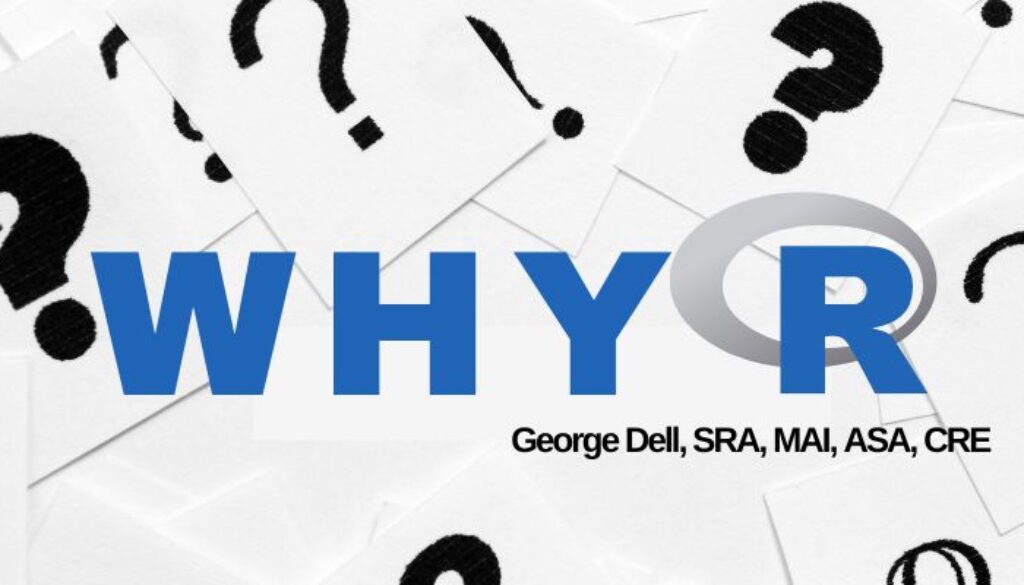Why the letter R?
R is a letter. It may be the most important letter to you since Sesame Street!
Appraisal services as we have known them continue to decline. AVMs continue to capture a larger market share. Slowly, but surely. But the AVM industry has other issues.
Traditional, judgment-based appraisal was built on your personal knowledge of an area, as well as a property type. In fact, when I became an appraiser, “who you knew was as important as what you knew.” Personal mentorship and training from an experienced appraiser was critical – It was absolutely necessary. The only way to “become an appraiser.”
Residential appraisers worked out of hard copy “comp books” which came out every three months. More recent listings came out every month. You could check the public records. If you were lucky, you had “Microfiche” to verify actual sales from public records. Transparent plastic sheets with micro print. You put them in your special machine, and could read and even “thermofax” print a whole sheet at a time. My first appraisal reports were in pencil. Then we had to start using typewriters. Why? Seemed unreasonable! Our judgment was not enough. Now they wanted typed and neat and pretty too! Grrr!
Non-residential appraisals mostly meant you started with public records, then made verifying phone calls to the brokers to get deeper information. Once you had four or five, your job was 80% done. Appraising was 80% getting the data. There were few adjustments. Mostly you did ‘qualitative’ analyses, by bracketing the comps around the subject features and cap rate. The office typist/secretary typed. I signed.
Then we got data. All kinds of sales. Each property type had its own color paper! Very time saving, but expensive. Then came the spreadsheet! We could make dollar adjustments easily! And automatically add and subtract numbers! Just like accountants!
Technology has evolved. From pencils to typewriters and hand calculators, to DOS, to residential forms software and spreadsheets — designed for bookkeepers. Then came the add-ons. Statistics, and even graphs (clumsy, but possible).

What’s next?
R.
R is a statistical analysis program. Do not use it directly. Too hard. No need.
Appraisers and asset analysts use RStudio. RStudio is a user interface, on top of R. It combines the best of mouse point-and-click, text code, and intelligent interactive drop-down pick-lists. Large, high-resolution screens mean you just move your eyes, and make decisions. Your brain and the computer directly connect to work together. Together.
RStudio and the many other free, open-source packages all serve to make the analyst work better, faster, more fun, and much more useful to our clients.
R, RStudio, and R packages are designed for analysts, like appraisers. A practical blend of the best of what AVMs do, and what appraisers do. The appraiser decides on the model to use. R carries out the algorithm based on what the expert appraiser determines. The only cost is the learning. The software is open-source, free.
Yes, there is a learning curve. In the Stats, Graphs, and Data Science classes, we do provide this software, and show how to use it with how you do appraisals today. We also teach the fundamentals of the data science, and how to get better, faster results.
The tools, the knowledge – make appraising more fun, while you grow toward the needs of tomorrow.
Get the free weekly blog and class discounts at: georgedell.com

July 20, 2022 @ 2:01 am
Good synthesis of our history with data availability, collection, analysis.
July 20, 2022 @ 8:57 am
RRR matey, full speed ahead.
July 26, 2022 @ 8:56 am
I’ve been using R developing adjustments for years.
March 18, 2023 @ 9:06 am
Timely topic in light of Fannie Mae’s initiative to update appraisal forms. The abundance of and ease of retrieving data needs to be addressed in appraisal practice.